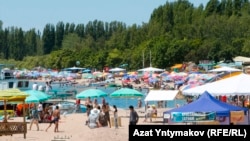
"There is no way to pass all these cars," my driver, Daniyar, says as we slowly make our way along the southern road of Issyk-Kul, Kyrgyzstan's giant lake in the northeastern corner of the country.
I can see that is true. There are more than a dozen cars up ahead flying the flags of the Social Democratic Party of Kyrgyzstan (SDPK) and then another 10 or so between us and the political-promotion convoy.
We're headed to Karakol, on the eastern corner of Issyk-Kul. There are only a few days left before the October 4 parliamentary elections and party activists are moving quickly to get in some last-minute campaigning. As we head east through the village of Kyzyl-Suu, a convoy of vehicles flying Ata-Meken party flags drives by us heading west.
A few kilometers farther down the road the SDPK's' convoy turns around at a gas station and heads back west. Just before we arrive in Karakol, we see another convoy of vehicles -- this one flying the flags of the Kyrgyzstan party -- also heading west.
We make it to Karakol, once named Przhevalsk, after the intrepid late-19th-century Russian explorer Nikolai Przhevalsky, who put large parts of inner Asia on the map. Przhevalsky, a Russia military officer with extensive training in cartography, made several expeditions through the Tien-Shan and Pamir mountains, the area now called Xinjiang in western China, Mongolia, and Tibet. Przhevalsky is buried just outside Karakol, with the monument to him looking across Issyk-Kul toward Lhasa, one the few destinations Przhevalsky wished to visit but never reached.
One of the first buildings we see when we enter Karakol is the local party headquarters of Onuguu-Progress, and since people are walking out, I decide to walk in.
"How do you think Onuguu-Progress will do in elections?" I ask the three party activists -- two Kyrgyz women who look to be in their 40s and a Kyrgyz man who looks around 50.
"Onuguu-Progress will be successful," one of the women, Jarkin, says.
"You say 'successful' -- how many seats do you think the party will win?" I ask.
"Thirty, maybe 40," she says.
"Forty, maybe a few more," the man, Cherekbai, says.
That is unlikely, since there are only 120 seats in the parliament and -- based on what I've seen and heard around Kyrgyzstan -- Onuguu-Progress would be fortunate to receive half the Karakol party supporters' estimates, even despite its heavy presence.
I was at a well-attended Onuguu-Progress rally in Nookat, in southern Kyrgyzstan. And Onuguu-Progress has been active throughout the country, with banners and posters everywhere I've been on this trip.
Downtown Karakol is an interesting place these days. It is a stop-off spot for foreign bicyclists and backpackers and also, apparently, where the Chinese managers of road projects like the Naryn-Issyk-Kul road, which we traveled to reach Karakol, prefer to live.
Party banners and flags are plentiful, and suspended on wires over the road are images of candidates from various parties, almost always featuring local politicians. (Sometimes these candidates are shown side-by-side with the party's national leader.)
That has also been true throughout the country. Ata-Meken leader Omurbek Tekebaev, for example, can be seen on thousands of posters across Kyrgyzstan, and his partners in the photos vary regionally to show local candidates in the Ata-Meken party.
It seems like eight or nine parties will be splitting the bulk of the vote in Karakol, at least based on what the people I met told me. That's interesting, because in nearly every other place I have been, there were only four or five parties that people mentioned.
As we head out of Karakol the next day, there is a convoy of vehicles assembling with flags of the Kyrgyzstan party. Once we're out on the road, we pull in behind a convoy of vehicles from the Bir Bol party.
The next stop is Cholpon-Ata, the tourist center of Issyk-Kul, since it is also the location of the best beaches on the lake's shoreline. And that's saying something. Issyk-Kul is some 160 kilometers across from east to west and in places some 60 kilometers across from north to south; at its deepest, it's nearly 900 meters to the bottom. The Soviet military used to test torpedoes at Issyk-Kul, and the torpedo factory is at the southwest end of the lake.
I can see that more recently, Cholpon-Ata has been doing well. The first time I came here was July 1992 and the town was not much to look at; but the beach was, and it was visible from the road through Cholpon-Ata. The accommodations were modest, but who cared? It's a beautiful place.
Now it's impossible to see the beach from the road through town. There are new buildings everywhere, restaurants, stores, boutiques, and a line of recently built hotels right down by the water that block the view of the beach.
That being the case, I am not surprised to hear that most residents here are going to vote and intend to vote for the same parties that are currently in the government -- the SDPK, Ata-Meken, and Respublika Ata-Jurt. Residents here have it good, and the situation is likely to get even better since the new airport in nearby Tamchi was finally completed earlier this year (they were working on it when I was last here in 2006).
Tomorrow is the last day of official campaigning and I'm headed to the capital, Bishkek, to watch the big event on October 4.






